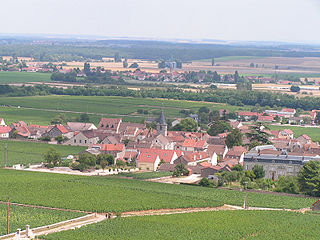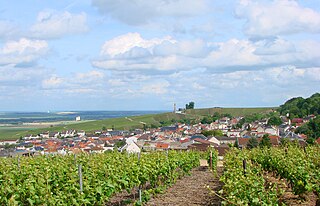
The wine region within the historical province of Champagne in the northeast of France is best known for the production of champagne, the sparkling white wine that bears the region's name. EU law and the laws of most countries reserve the term "champagne" exclusively for wines that come from this region located about 160 kilometres (100 miles) east of Paris. The viticultural boundaries of Champagne are legally defined and split into five wine-producing districts within the historical province: Aube, Côte des Blancs, Côte de Sézanne, Montagne de Reims, and Vallée de la Marne. The city of Reims and the town of Épernay are the commercial centers of the area. Reims is famous for its cathedral, the venue of the coronation of the French kings and a UNESCO World Heritage Site.

Burgundy wine is made in the Burgundy region of eastern France, in the valleys and slopes west of the Saône, a tributary of the Rhône. The most famous wines produced here, and those commonly referred to as "Burgundies", are dry red wines made from pinot noir grapes and white wines made from chardonnay grapes.

Clos de Vougeot, also known as Clos Vougeot, is a wall-enclosed vineyard, a clos, in the Burgundy wine region, and an Appellation d'origine contrôlée (AOC) for red wine from this vineyard. It was named for the River Vouge, which is in fact only a stream separating the village Vougeot from Chambolle-Musigny. At 50.6 hectares, Clos de Vougeot is the largest single vineyard in Côte de Nuits entitled to the grand cru designation, while Corton in Côte de Beaune is the largest grand cru in Burgundy as a whole.

Vosne-Romanée is a commune in the Côte-d'Or department in Bourgogne-Franche-Comté in eastern France.

The Côte de Nuits is a French wine region located in the northern part of the Côte d'Or, the limestone ridge that is at the heart of the Burgundy wine region. It extends from Dijon to just south of Nuits-Saint-Georges, which gives its name to the district and is the regional center. Though some white and rosé wines are produced in the region, the Côte de Nuits is most famous for reds made from pinot noir. The Côte de Nuits covers fourteen communes. Six produce grand cru wines, in the central district between Gevrey-Chambertin and Nuits-Saint-Georges, with four lesser villages either side. The Grand Crus of the Côte de Nuits are some of the smallest appellations in France, less than a hectare in the case of La Romanée.

The arrondissement of Épernay is an arrondissement of France in the Marne department in the Grand Est region. It has 208 communes. Its population is 116,465 (2021), and its area is 2,722.4 km2 (1,051.1 sq mi).
Krug Champagne is a Champagne house founded by Joseph Krug in 1843. It is based principally in Reims, the main city in France's Champagne region and is one of the famous Champagne houses that formed part of the Grandes marques. Today the house is majority owned by the multinational conglomerate LVMH Moët Hennessy – Louis Vuitton S.E. whose portfolio includes other well known wine brands such as Moët & Chandon, Veuve Clicquot, Château d'Yquem and Ruinart. Despite LVMH's majority ownership, the Krug family is still actively involved in all the key decisions of the house but does not manage the day-to-day operations.

The Confrérie des Chevaliers du Tastevin is an exclusive Bacchanalian fraternity of Burgundy wine connoisseurs.

Romanée-Conti is an Appellation d'origine contrôlée (AOC) and Grand Cru vineyard for red wine in the Côte de Nuits subregion of Burgundy, France, with Pinot Noir as the primary grape variety. It is situated within the commune of Vosne-Romanée and is a monopole of the winery Société Civile du Domaine de la Romanée-Conti, which takes its name after this vineyard. Romanée-Conti borders on La Romanée in the west, Richebourg in the north, Romanée-Saint-Vivant in the east and La Grande Rue in the south. The AOC was created in 1936.

Échezeaux is an Appellation d'origine contrôlée (AOC) and Grand Cru vineyard for red wine in the Côte de Nuits subregion of Burgundy, with Pinot noir as the main grape variety. Échezeaux is located within the commune of Flagey-Echézeaux, on a strip of land between the territory of the communes Vosne-Romanée, Vougeot and Chambolle-Musigny. Échezeaux borders on the Clos de Vougeot and its wall as well as Grands Échezeaux in the east, on Chambolle-Musigny vineyards in the north, some Vosne-Romanée vineyards in the west and on the Vosne-Romanée Premier Cru vineyard Les Suchots in the south. The AOC was created in 1937.

Grands Échezeaux is an Appellation d'origine contrôlée (AOC) and Grand Cru vineyard for red wine in the Côte de Nuits subregion of Burgundy, with Pinot noir as the main grape variety. Grands Échezeaux is located within the commune of Flagey-Echézeaux, on a strip of land between the territory of the communes Vosne-Romanée, Vougeot and Chambolle-Musigny. Grands Échezeaux borders on Clos de Vougeot and its wall in the east and north, and on Échezeaux in the west and south. The AOC was created in 1936.

Bouzy is a commune of the Marne department in northeastern France, the Montagne de Reims subregion of Champagne.
Maison Louis Latour is a merchant and owner of red and white wines in Burgundy, France. It has remained independent and family-owned since 1797. Maison Louis Latour has the largest holding of Grand Cru in the Côte d'Or with a total of 28.63 hectares.

Duval-Leroy is a Champagne producer based in Vertus, a village in the Côte des Blancs region of Champagne. The house, founded in 1859, produces both vintage and non-vintage cuvées as well as a line of organic wines. The house of Duval-Leroy is also known for its pioneering role in promoting a sustainable development model for its viticulture.

The classification of Champagne vineyards developed in the mid-20th century as a means of setting the price of grapes grown through the villages of the Champagne wine region. Unlike the classification of Bordeaux wine estates or Burgundy Grand cru vineyards, the classification of Champagne is broken down based on what village the vineyards are located in. A percentile system known as the Échelle des Crus acts as a pro-rata system for determining grape prices. Vineyards located in villages with high rates will receive higher prices for their grapes than vineyards located in villages with a lower rating. While the Échelle des Crus system was originally conceived as a 1-100 point scale, in practice, the lowest rated villages are rated at 80%. Premier crus villages are rated between 90 and 99 percent while the highest rated villages, with 100% ratings are Grand crus.
Jacquesson & Fils is a Champagne producer based in the Dizy region of Champagne. The house was founded in Châlons-sur-Marne in 1798 by Memmie Jacquesson. The house makes the claim it is the oldest independent Champagne house.

Gevrey-Chambertin wine is produced in the communes of Gevrey-Chambertin and Brochon in the Côte de Nuits subregion of Burgundy. The Appellation d'origine contrôlée (AOC) Gevrey-Chambertin may be used only for red wine with Pinot noir as the main grape variety. There are nine Grand Cru vineyards within the commune of Gevrey-Chambertin, Chambertin and eight others called Chambertin in combination with something else, such as Chapelle-Chambertin. While Gevrey-Chambertin also has several highly regarded Premier Cru vineyards, it has a particularly large amount of vineyards at the village level for a Côte de Nuits appellation. This is because the vineyards of the AOC stretch further to the east than in most neighbouring AOCs.

Montagne de Reims Regional Natural Park is a protected area in the Grand Est region of France. It is organized around the Montagne de Reims, a wooded range of hills covered by vineyards that produce the region's eponymous sparkling wine, Champagne.

Boll & Cie is a Champagne house based in Reims, a producer of sparkling wines from the Champagne region of France, founded in 1853. With the exception of the Brut Rose, all Champagnes from Boll & Cie are blanc de blancs. Boll & Cie specializes in Brut Champagne, including a Grand Cru from the village of Le Mesnil-sur-Oger.
Communauté d'agglomération Épernay, Coteaux et Plaine de Champagne is the communauté d'agglomération, an intercommunal structure, centred on the town of Épernay. It is located in the Marne department, in the Grand Est region, northeastern France. Created in 2017, its seat is in Épernay. Its area is 586.9 km2. Its population was 47,514 in 2019, of which 22,433 in Épernay proper.



















